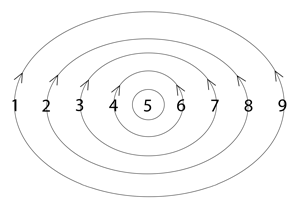anger
6-3-9
Conventional Understanding
We’re taught that anger is a problem to fix—a disruptive emotion that clouds judgment and damages relationships. “Count to ten,” they say, or “channel it productively.” Society positions anger as an unwanted intruder rather than valuable information. This limited view leads us to either suppress anger entirely, judge ourselves for experiencing it, or indulge it without awareness. By treating anger as the enemy, we miss what it’s actually showing us about our boundaries and needs.
Resonant Understanding
Word Cosmology reveals “anger” carrying a 6-3-9 resonance pattern, sharing this numeric signature with “have,” “care,” and “real.” Like a river forming banks as it flows through landscape—not creating the landscape but revealing the natural boundaries of its flow—anger doesn’t create our experience but indicates where our sense of territory meets resistance. This transforms our understanding from seeing anger as a disruptive emotion to recognizing it as a boundary alert system that shows us exactly where something we value is being encroached upon.
Expressions Spectrum Analysis
In balanced expression, this resonance pattern appears as “govern reality,” “creative expression,” and “care,” revealing how this boundary-indicating pattern naturally defines without rigidity. “Health” and “grow” show that clear boundaries support development rather than restricting it. “In the present” demonstrates how balanced expression stays engaged with immediate experience rather than dwelling on past violations or worrying about future threats.
When over-modulated, expressions include “anger” itself, “control system,” and “forcing,” showing how boundary recognition becomes rigid and inflexible. “I am superior” and “tyranny” demonstrate how over-modulation corresponds with dominance rather than natural delineation. “Becoming an identity” reveals how a functional pattern transforms into a fixed self-definition.
Under-modulated expressions such as “denial,” “despair,” and “in the dark” show what happens when boundary recognition becomes diffuse or collapsed. “Living in fear” and “I am vulnerable” reveal the insecurity that appears when boundaries lack sufficient definition. “Self-critical” indicates how under-modulation turns boundary violation inward rather than addressing external incursions.
Beyond these modulation patterns, words like “magnetic,” “light of mind,” and “pressure exchanges” also share this resonance pattern, suggesting connections with field dynamics and processes that occur at boundaries between different systems.
Russell’s Cosmogony Connection
Walter Russell’s understanding of boundaries illuminates this resonance pattern. In “A New Concept of the Universe,” Russell writes:
“Polarity extends its surveyed measure of desire from a zero point of rest in the universal Light to two extended zero points of rest where motion reverses its direction, its polarity and its condition.”
This describes the boundary-defining function that appears in balanced expressions like “govern reality” and “have.” Like a surveyor marking property lines, this resonance pattern doesn’t create territory but reveals its existing extent.
Russell explains that “electric strains and tensions” emerge when balance is disturbed. This connects directly to how anger functions—when boundaries are respected, strain dissipates; when boundaries are violated, tension increases until balance is restored. This isn’t emotional reactivity but the same principle operating throughout creation—the natural tension at interfaces between different pressure conditions.
Practical Implications
This understanding transforms our approach to anger from “anger management” to “boundary recognition.” Rather than suppressing anger (which often leads to depression) or expressing it destructively, we can use it as valuable information about where our boundaries need attention.
When anger arises, we might ask: What’s being encroached upon that matters to me? Where do I need to establish clearer limits? What legitimate territory am I responsible for protecting? This shifts our relationship with anger from problem to partnership.
This perspective challenges narratives that frame anger as inherently destructive. Just as pain warns of physical danger, anger alerts us to boundary violations—both are valuable messengers, not enemies to overcome. People who consistently suppress anger often develop depression because they’re disabling their entire boundary recognition system.
By recognizing anger as boundary wisdom rather than personal failing, we can maintain the dynamic balance that supports both personal integrity and meaningful connection. The goal isn’t eliminating anger but understanding its message and responding appropriately—neither under-reacting through boundary collapse nor over-reacting through rigid control.
Walter Russell’s quotes are from his book, “A New Concept of the Universe”.


